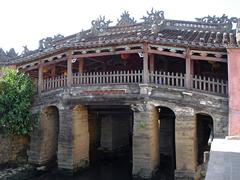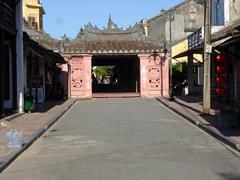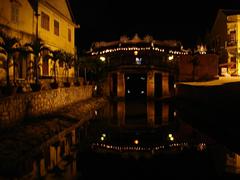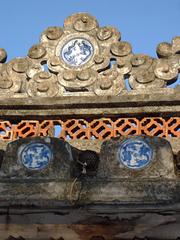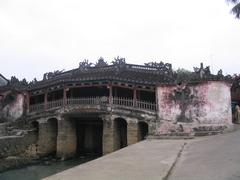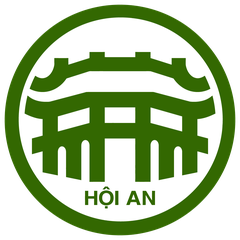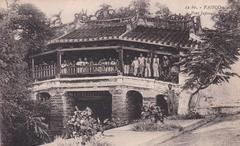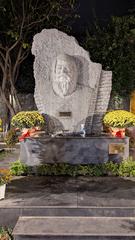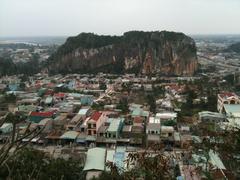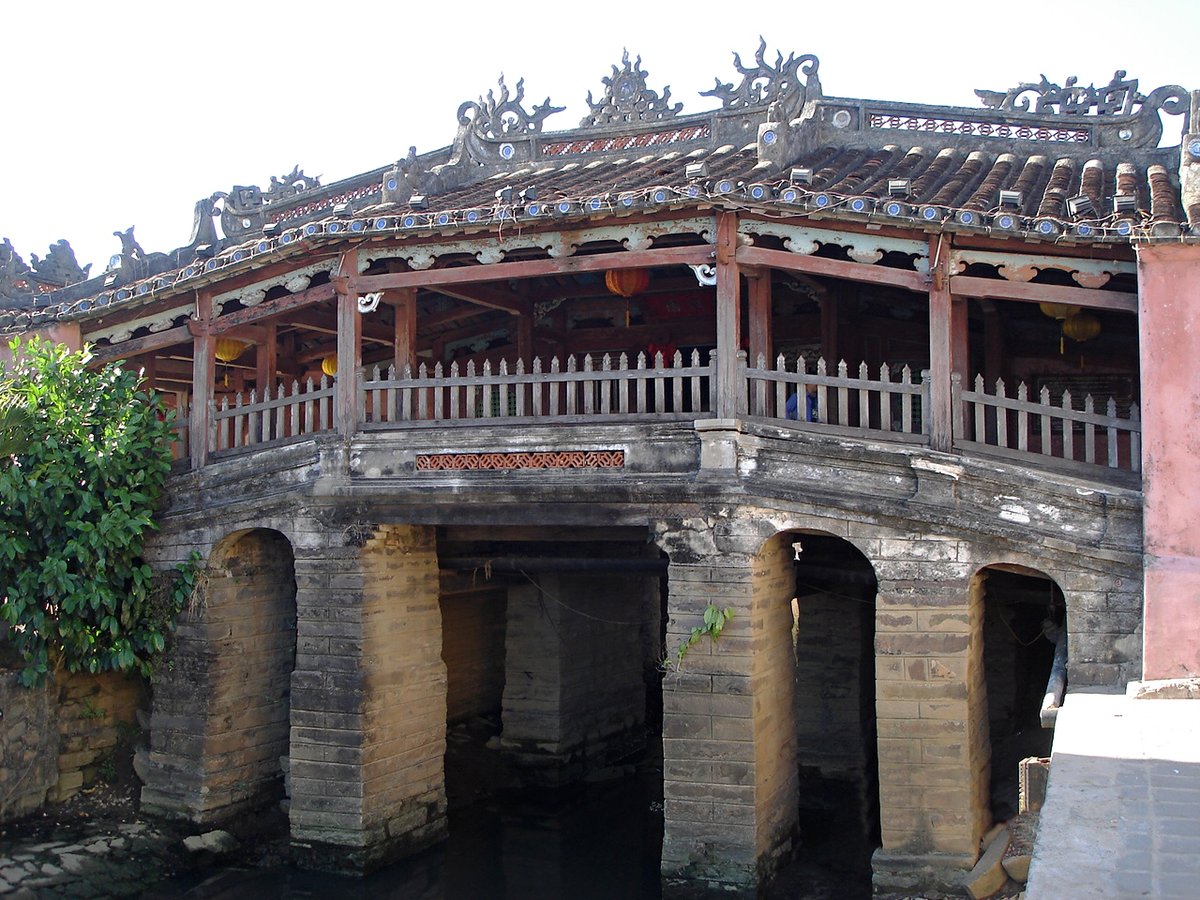
Japanese Bridge Hội An, Vietnam: Visiting Hours, Tickets, and Comprehensive Travel Guide
Date: 15/06/2025
Introduction: The Japanese Bridge of Hội An—History and Cultural Significance
In the heart of Hội An’s UNESCO World Heritage Old Town, the Japanese Bridge (Chùa Cầu) stands as an enduring symbol of cross-cultural harmony and historical depth in Central Vietnam. Erected in 1593 by Japanese merchants, the bridge connected the Japanese and Chinese quarters of the bustling trading port, reflecting Hội An’s status as a nexus of international commerce and cultural exchange. The bridge’s unique architecture—melding Japanese carpentry, Chinese decorative motifs, and Vietnamese craftsmanship—culminates in its iconic tiled roof and small temple dedicated to Bac De Tran Vu, a Taoist deity revered for protecting the town.
Having undergone numerous restorations, most recently completed in 2025, the Japanese Bridge continues to serve as a living monument to international cooperation, spiritual tradition, and artistic legacy. It is not only a crossing but a journey into Hội An’s multicultural past—celebrated on the Vietnamese 20,000 VND banknote and in local art, festivals, and national consciousness.
This guide provides an in-depth look at the Japanese Bridge’s history, architecture, symbolism, practical visitor details (hours, tickets, accessibility), travel tips, nearby attractions, and essential FAQs to ensure a seamless and enriching visit. For official updates, refer to the Hội An Tourism Official Website and Hoi An Center for Cultural Heritage Conservation Management.
Table of Contents
- Discover the Japanese Bridge: A Must-Visit Hội An Historical Site
- Historical Background and Evolution
- Visiting the Japanese Bridge: Practical Information
- Symbolism and Cultural Significance
- Frequently Asked Questions (FAQ)
- Visual Highlights
- Nearby Attractions and Suggested Itineraries
- Plan Your Visit and Stay Connected
- Summary and Final Travel Recommendations
- References and Further Reading
Discover the Japanese Bridge: A Must-Visit Hội An Historical Site
The Japanese Bridge (Chùa Cầu) is among Vietnam’s most celebrated landmarks, symbolizing Hội An’s rich tapestry of cultural influences. Originally linking the Japanese and Chinese quarters, the bridge is an architectural and spiritual gem, drawing history enthusiasts, photographers, and travelers from around the globe. This guide offers detailed insights into the bridge’s legacy, visitor essentials, and tips for making the most of your visit.
Historical Background and Evolution
Origins and Construction
The Japanese Bridge was constructed in 1593 by Japanese merchants to facilitate trade and foster connections with the Chinese quarter across a Thu Bồn River tributary. This strategic crossing reinforced Hội An’s cosmopolitan character during its zenith as a Southeast Asian trading hub.
Architectural Features and Cultural Influences
The bridge showcases a harmonious blend of architectural styles. Its wooden, arched structure with a tiled roof is distinctly Japanese, while Chinese motifs and Vietnamese craftsmanship are evident in the ornate carvings and construction techniques. A small temple dedicated to Bac De Tran Vu occupies the bridge’s center, emphasizing its spiritual role. Guardian statues of dogs and monkeys at either end serve as protectors, rooted in Eastern symbolism.
Historical Evolution and Renovations
- Initial Naming and Significance: The bridge was soon dubbed “Chùa Cầu” (Pagoda Bridge) after the addition of the temple. In 1719, Lord Nguyen Phuc Chu inscribed the bridge with “Lai Viễn Kiều” (“Bridge that receives guests from afar”).
- Shifts in Community: Japanese residents departed after the Tokugawa shogunate’s isolationist policies (1633), but the bridge’s multicultural character endured.
- Restoration Timeline: Significant restorations occurred in 1817, 1823, 1875, 1915–1917, 1986, and most recently from 2023 to 2025, preserving both structure and artistry (asiamystika.com; vietnamnet.vn).
Visiting the Japanese Bridge: Practical Information
Visiting Hours
- Bridge Crossing: Open daily, typically accessible 24/7 for foot traffic.
- Temple Access: Generally open from 8:00 AM to 5:00 PM.
Ticket Information
- Access: Crossing the bridge is free; entry to the temple and several heritage sites requires the Hội An Old Town ticket.
- Ticket Price: Approximately 120,000 VND ($5 USD) for adults, with discounts for students and children.
- Purchase Locations: Tickets are available at Old Town entrance gates and official tourism websites (hoianworldheritage.org.vn).
Accessibility
- The bridge is pedestrian-only, with steps at either end. While the ancient town is largely flat and walkable, the bridge’s steps may present challenges for visitors with mobility impairments.
Travel Tips
- Best Times: Visit early morning or late afternoon for softer light and fewer crowds.
- Attire: Modest clothing is recommended, especially when visiting the temple.
- Weather: February–April and September–November feature the most pleasant weather.
- Guided Tours: Enhance your experience with guided tours that include the Japanese Bridge and other Hội An historical sites.
- Responsible Tourism: Respect the bridge’s preservation by avoiding littering, defacing, or climbing on structures.
Symbolism and Cultural Significance
The Japanese Bridge is more than an architectural feat—it is a living symbol of Hội An’s multicultural heritage and spiritual life. Its image graces the Vietnamese 20,000 VND banknote and is a focal point in art, festivals, and community celebrations. The bridge’s legend, linking it to the mythical Namazu catfish and providing spiritual protection, underscores its role in local folklore.
Frequently Asked Questions (FAQ)
Q: What are the Japanese Bridge visiting hours?
A: The bridge is accessible 24/7 for crossing; the temple inside is typically open from 8:00 AM to 5:00 PM.
Q: Do I need tickets to visit the Japanese Bridge?
A: Crossing is free, but the Hội An Old Town ticket (approx. 120,000 VND) is required for temple access and other heritage sites.
Q: Is the bridge accessible for people with disabilities?
A: The bridge has steps which may be difficult for some visitors; the surrounding old town is generally accessible.
Q: Are guided tours available?
A: Yes, local guides offer tours incorporating the Japanese Bridge and other landmarks.
Q: Can I take photos on the bridge?
A: Absolutely. The bridge is especially photogenic at sunrise, sunset, and during lantern festivals.
Visual Highlights
Japanese Bridge with tiled roof and wooden arch; clay dog and monkey statues at each entrance.
Interactive maps and virtual tours are available on official tourism sites, helping plan your route through Hội An’s historical core.
Nearby Attractions and Suggested Itineraries
Within walking distance of the Japanese Bridge, visitors can explore:
- Hội An Ancient Town: UNESCO-listed streets, vibrant markets, and ancient houses.
- Thanh Hà Pottery Village: Traditional pottery making, 3 km west.
- Hội An Market: Street food, souvenirs, and fresh produce.
- Duc An Ancient House: Merchant house reflecting historic architecture.
- Local Museums and Assembly Halls: Showcasing the town’s multicultural past.
Combine these with your bridge visit for a well-rounded cultural experience (vncarrentals.com).
Plan Your Visit and Stay Connected
- Travel Apps: Download the Audiala mobile app for guided tours, local insights, and real-time updates on Hội An historical sites.
- Weather Preparedness: Bring an umbrella or raincoat in the rainy season, and sun protection during hot months.
- Souvenirs: The Japanese Bridge appears on the 20,000 VND banknote and is a popular motif for postcards and handicrafts.
- Language: English is widely spoken in tourist areas, and most signage is bilingual.
- Responsible Tourism: Support local artisans and sustainable travel practices.
For official updates, consult the Hội An Tourism Official Website and the Hoi An Center for Cultural Heritage Conservation Management.
Summary and Final Travel Recommendations
The Japanese Bridge in Hội An is an emblem of centuries of cultural exchange and architectural refinement. Its harmonious design, spiritual legacy, and central role in the town’s identity make it a must-see for all visitors. Plan your visit during off-peak hours, combine it with nearby attractions, and use digital resources for a richer experience. By respecting its heritage and engaging with local culture, travelers help ensure the bridge remains a vibrant symbol for generations to come.
References and Further Reading
- Hội An Tourism Official Website
- Hoi An Center for Cultural Heritage Conservation Management
- Japanese Covered Bridge in Hoi An: History, Visiting Hours, Tickets, and Travel Tips
- Japanese Bridge Hội An: Visiting Hours, Tickets, Architectural Highlights, and Travel Guide
- Japanese Covered Bridge Visiting Hours, Tickets, and Guide to Hội An Historical Sites
- Hoi An’s Japanese Bridge Reopens After Two Years of Restoration
- Good Morning Hoi An: Japanese Bridge
- Hidden Hoi An: Japanese Bridge
- Expatolife: Japanese Bridge Hoi An
- Bliss Hoi An: Best Time to Visit
- VNCarrentals: Japanese Covered Bridge
